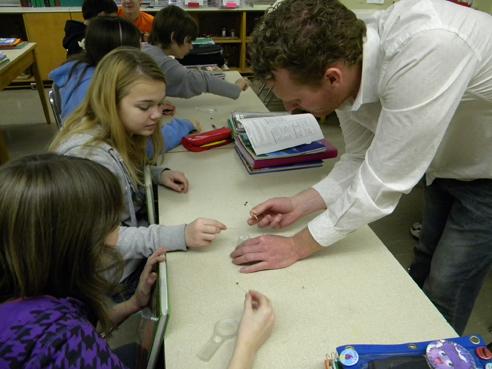Symbi researchers give back

Photo Courtesy: Lindsey Long, Center for Biorenewable Resources
Mark Newell, graduate in agronomy and Symbi Fellow, teaches students about pollination at Brody Middle School in Des Moines.
February 2, 2011
Doing research can be a valuable addition to any resume, and a way to give back to the community. One program that started at Iowa State last fall is doing both of those things with a focus on renewable, efficient energy.
Symbi, Iowa’s GK-12 program, has placed six ISU graduate students into three Des Moines’ middle schools to share their research in a practical, hands-on way. In return for working one full day per week in the schools, the students get a $30,000 grant for their research and a scholarship for tuition.
The program is funded by the National Science Foundation, and Iowa State’s is one of only 15 such GK-12 engineering research centers in the United States. Next year, the program hopes to increase from six to nine fellows.
“The National Science Foundation is very concerned that grad students are being trained to communicate their research and science within a very narrow field. They want to change this approach,” said Adah Leshem-Ackerman, program director of the Center for Biorenewable Chemicals and Symbi.
By teaching at the middle school level, the fellows are forced to have a real-world twist to their research, and present it in an accessible, hands-on way.
Grad students who have participated in the program say it has helped them to improve their communication skills, and community outreach is also something employers look for.
Most of the researchers want to go on to careers in research or teaching at the university level, so teaching at the middle school level is a different feeling.
“It’s a very unique experience to learn more about what happens in pre-college,” Leshem-Ackerman said.
He said the graduate students, who act more like resident scientists than teachers or teaching assistants, serve as role models for the middle schoolers, since they’re not that much older and don’t fit the lab-coat scientist stereotype.
“The kids are very bright, but they don’t see scientists ever,” said Leshem-Ackerman of the middle schoolers in Brody, Harding and Meredith middle schools. Sixty percent of the students in these schools recieve free or reduced-price lunches, which is an indicator of lower socioeconomic status. Leshem-Ackerman said this can mean that parents don’t know to encourage scientific inquiry, and teachers are often too busy managing the classroom.
Enter the fellows.
“I think there’s a disconnect between what goes on in science classrooms and what goes on in science,” said Mark Newell, graduate student in agronomy.
Ben Lewis, graduate student in genetics, development and cell biology, said that working with students on their science fair projects has helped them to see that those posters aren’t that different from what real researchers make. He said the kids have developed enough so that they can have a scientific dialogue.
Heather Edwards, graduate student in chemistry, said that she has seen her students having more fun with science, and coming up with their own labs.
For example, after learning about heat transfers by making ice cream, the students could design their own ice cream experiment using sugar, salt or neither to freeze it.
Lewis said the biggest thing they teach hasn’t been the actual subjects, but rather what it means to think like a scientist.
He said the fellows aim to “combat scientific illiteracy,” on a wide level, rather than really train a new generation of scientists.
However, Leshem-Ackerman said this is part of the reason they decided to focus their program on middle-school students — so if they have an interest in pursuing science as a career, they can start in high school.
Leshem-Ackerman said that bioeconomy and wind energy will continue to grow in Iowa, but only if there is a workforce of scientists to support it.






